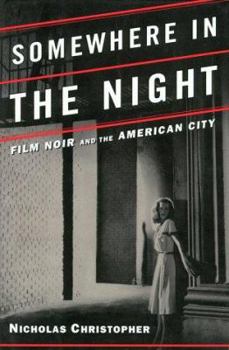Somewhere in the Night
Select Format
Select Condition 
Book Overview
Starting with the classic Out of the Past, Christopher takes us on the grand tour of the great film noirs. With style and humor, he identifies the genre's central motif -- "The city as labyrinth is... This description may be from another edition of this product.
Format:Hardcover
Language:English
ISBN:0684828030
ISBN13:9780684828039
Release Date:March 1997
Publisher:Free Press
Length:290 Pages
Weight:1.33 lbs.
Dimensions:1.0" x 6.4" x 9.6"
Customer Reviews
3 ratings
Here it is, the simple version.
Published by Thriftbooks.com User , 17 years ago
This is a straight forward and simple review. I feel it would be redundant going into the detail that the other reviews (who explained the book perfectly) already did. This book changed my life. I read it as a senior in high school in a film noir class. It opened my mind up to enjoying film beyond the crappy new-age Hollywood hit list. If you enjoy a more realistic movie: a grittier, hard-edged, unapologetic look at urban drama, then I think this book will open your eyes. It changed the way I looked at film (for the better) and I think it will for anyone else who reads it.
Elaborate Exploration of Classic Noir's Urban Jungle.
Published by Thriftbooks.com User , 20 years ago
"Somewhere in the Night" is a treatise on film noir focusing on the characteristics of the post-WWII urban environment which spawned and defined the style. Novelist and poet Nicholas Christopher draws on a wider variety of sources to explain film noir than most film theorists do, including social pundits, historians, artists, and film critics. The discussion of film noir's influences goes so far beyond the traditional expressionism and post-War conditions that the connection is sometimes dubious, but always interesting. "Somewhere in the Night" almost overlooks the first 5 or so years of film noir, picking it up as the style peaks, in the mid-1940s. Each of the book's 8 chapters discusses a characteristic of the Noir City, and most include in-depth analysis of a few films that exemplify that quality. Most discussion is of classic film noir until the last chapter, which is dedicated to neo-noir. Readers will benefit from having some knowledge of film noir theory and history before embarking on this book, since the author presents an elaborate and personal picture of the social circumstances into which film noir emerged but doesn't cover the basics. "Somewhere in the Night" is a thoughtful dissertation for film noir buffs, by a film noir buff. The films mentioned below are not by any means the only films discussed, but the ones which receive exhaustive treatment. Chapter 1, "Into the Labyrinth", introduces the reader to the literal and figurative urban labyrinth, a man-made web of treachery, which the heroes of film noir are compelled to navigate. "Out of the Past" (1947) and "Kiss Me Deadly" (1955) get in-depth analysis. Chapter 2, "Night and the City", discusses how the aftermath of WWII -the fears of the nuclear age, the paranoia of the Cold War, and the disillusionment of veterans- influenced film. Chapter 3, "Postcards from the Ruins", analyses 3 films that feature Americans in devastated European cities: "Berlin Express" (1948), "The Third Man" (1949), and "Night and the City" (1950). Chapter 4, "Office Buildings and Casinos", explores the increased sense of isolation produced by technologies and the corporate "rat race", reflected in characters' gravitation to omnipresent office buildings or casinos. 3 office work films are analyzed: "Forces of Evil" (1948), "The Big Clock" (1948), and "The Blue Gardenia" (1953), as well as 4 casino films: "Dead Reckoning" (1947), "Criss Cross" (1949), and "The Shanghai Gesture" (1941), and "Gilda" (1946). Chapter 5, "Grafters, Grifters, and Tycoons", discusses money as the foundation of the noir city, manifested as artwork, gangsters, or political corruption. Films analyzed are "The Street with No Name" (1948), "T-Men" (1947), "The Set-Up" (1949), and "Caught" (1949). Chapter 6, "The Dark Mirror: Sex, Dreams, and Psychoanalysis", talks about noir's sexual obsessions, previously not depicted in film, the femme fatale, and Freudian psychoanalysis in cinema. "Gun Crazy" (1950), "Nightmare Alley" (1947), "The
Not Just the Usual Film Noir Suspects
Published by Thriftbooks.com User , 22 years ago
This isn't the perfect book on film noir, but it is very interesting because Christopher touches on films that don't get discussed in a lot of books on film noir.Chief among these are two Val Lewton horror films, Cat People and The Seventh Victim. It is nice to see someone discussing Lewton from a film noir perspective. Also, Christopher left me burning to see Breakdown, a 1965 film dealing with a scientist's mental crisis that he makes sound fascinating.He also does a good job talking about more famous noirs, particularly Criss Cross, which he examines from the Dan Dureyea character's perspective. That brings a fresh approach to his discussion of this classic film noir.This should not be anyone's first book on film noir, but it takes interesting positions and makes the reader look at things differently. Recommended for the person deeply into noir.






